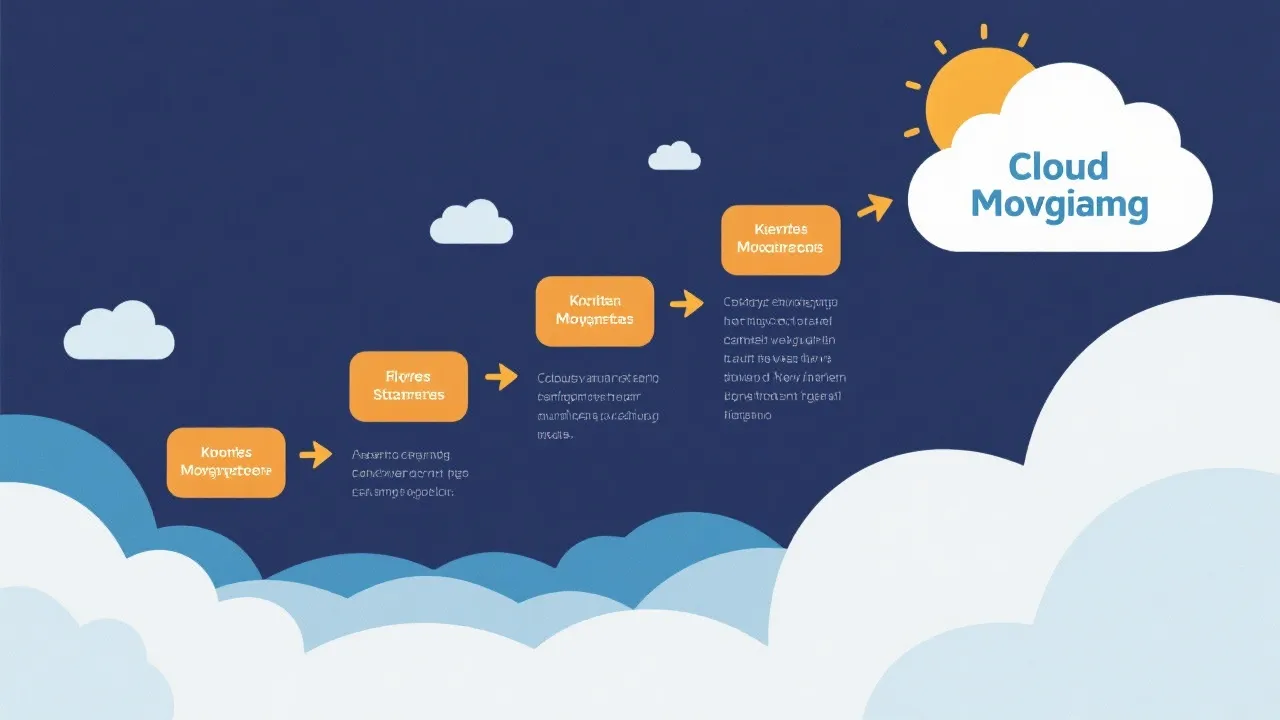Essential Steps for Successful Cloud Migration
Cloud migration is pivotal for businesses aiming for increased flexibility and cost savings. The process necessitates careful planning, provider evaluation, data handling, and employee adaptation to achieve seamless integration and enduring success.

Introduction to Cloud Migration
Moving to cloud environments is now crucial for modern businesses due to its scalable and efficient solutions. The reconfiguration from traditional IT setups to dynamic cloud platforms involves navigating a myriad of challenges; hence, meticulous execution is necessary to avert issues and ensure the shift goes smoothly. Cloud migration isn't merely a technical change; it's a transformative journey that impacts operational strategies, service delivery methods, and even corporate culture. Companies are increasingly recognizing that cloud technologies can enable innovation and drive strategic advantage. Understanding the fundamental principles surrounding cloud migration can be the groundwork for an organization’s successful transition into the cloud.
Strategic Planning for Migration
Kickstart your migration journey by evaluating current IT assets to pinpoint organizational demands. A comprehensive audit is essential; this includes inventorying hardware, software, applications, and processes to understand what resources are currently being utilized and their performance levels. Planning with caution entails considering legal issues such as data sovereignty and compliance regulations, security measures for sensitive data, and application necessities such as compatibility and integration capabilities. Collaborating with stakeholders across different divisions ensures that the migration strategy aligns with business goals and encompasses challenges faced by all departments. This collaborative approach fosters transparency and promotes inclusivity. One should also establish a structured framework with measurable goals from the outset for tracking progression, which will serve as benchmarks for evaluating success.
Selecting the Right Cloud Vendor
Selecting a cloud provider requires examining various options such as public, private, or hybrid models. Each model offers unique benefits that cater to differing organizational needs. For instance, public clouds are cost-effective and offer high scalability, while private clouds provide enhanced security for sensitive information. Hybrid clouds combine both models, allowing businesses the flexibility to scale resources as needed while maintaining control over critical applications. Analyze performance benchmarks, scalability options, support offerings, and security features, and engage in direct conversations with potential providers to ensure a thorough understanding of their offerings and how they align with business goals. Customer feedback and case studies serve as additional insights; organizations often find value in evaluating how other companies within their industry handled similar transitions. Additionally, assessing the vendor’s reliability, compliance with standards, and service level agreements (SLAs) will help prevent issues during and after the migration process.
Data Assessment and Mapping
Building upon the choice of a provider, the data assessment and mapping phase involves a meticulous examination for the identification of all applications and data to be transferred. This process is intricate and should not be rushed; it requires a thorough understanding of system dependencies and interconnections. Recognizing these dependencies aids in deciding on an ideal migration method—whether that entails a "lift-and-shift" approach, reengineering, or complete replacement of existing applications. Additionally, ensuring that data encryption and compliance are tightly woven into the migration protocol is pivotal; regulatory requirements can vary significantly across industries. Failing to adhere to these can not only affect operations but could also lead to severe legal consequences. A complete inventory of data, alongside visual data mapping, will assist in determining priority schedules for migration, ensuring that critical services remain uninterrupted during the process.
Testing Before Full Transition
Prior to final migration, it is prudent to conduct trials on less critical systems or a sandbox environment to spot potential pitfalls. These pilot tests serve as a crucial assessment phase, allowing organizations to gauge system adaptability in real-world scenarios. During this process, various metrics such as performance, integration capabilities, and user experience can be evaluated, pinpointing any issues that may arise under a cloud environment. Such insights direct any requisite strategy changes and ensure that the migration plan is robust. Furthermore, involving a cross-section of staff in these tests can provide you additional perspectives on usability and ease of access, thereby refining the overall approach for smooth integration. Adopting automated testing tools can also enhance the testing phase, as these can efficiently handle large volumes of data and simulate user interactions in ways that manual testing may overlook.
Training and Support for Staff
Transitioning to cloud technology demands comprehensive training for staff to become adept with new systems. Investment in training programs should not be overlooked; these programs should cover both the technical skills needed to operate the new systems and the strategic thinking necessary to leverage them effectively. Early engagement and training alleviate transitional challenges, fostering organizational commitment and enthusiasm around the new process. Training could involve hands-on workshops, online courses, or mentorship programs to help staff feel equipped and empowered. Furthermore, implementing a continuous feedback loop where employees can share their experiences and concerns promotes a culture of adaptability and learning. Continued IT support post-migration is also essential; having dedicated personnel available to answer questions and resolve issues promptly removes roadblocks and ensures operational consistency. This support can evolve into a knowledge base that grows as the organization expands its use of cloud services.
Post-Migration Analysis
Once migration is complete, monitoring performance against initial objectives is critical. Evaluating efficiency gains goes beyond metrics; it requires understanding how the migration translates to real-world productivity improvements. Gather user feedback to refine processes continually—this continuous improvement approach ensures that the cloud environment remains optimized and aligned with business needs. Regular reviews also cultivate a proactive stance towards cloud utilization; organizations should assess their cloud engagements periodically to identify areas that could benefit from enhancements. Furthermore, leveraging analytics tools to scrutinize usage patterns and resource consumption empowers decision-makers with data-driven insights. This analysis can guide potential cost reductions, performance improvements, and planning for future scalability, ensuring that the organization maximizes the return on their cloud investment.
Challenges to Anticipate During Migration
Despite careful planning, organizations may still encounter several challenges throughout the migration process. Identifying these potential hurdles early can greatly minimize disruption. Common issues include data loss or corruption during transfer, performance bottlenecks post-migration, or unexpected costs associated with cloud services, which can arise from overlooked pricing structures or added features. Communication breakdowns between IT teams and business units may also contribute to misalignment of expectations and project scope. Moreover, employee resistance to change can hinder the successful adoption of the new systems, resulting in underutilization. To combat these challenges, organizations should implement robust contingency plans and maintain open lines of communication throughout the migration process. Developing a risk management framework that identifies potential risks and outlines mitigation strategies is crucial. Regularly revisiting these frameworks during the migration phase allows teams to adapt quickly to unexpected issues and ensures a smoother transition overall.
Future-proofing Your Cloud Strategy
With the rapid evolution of technology, adopting a long-term view of cloud strategy is crucial. Future-proofing your cloud infrastructure involves anticipating trends and how they can impact your architecture, workloads, and overall IT strategy. Emerging technologies such as artificial intelligence, machine learning, and the Internet of Things (IoT) are reshaping how businesses operate, and organizations must consider how their cloud solutions align with these advancements. Planning for increased automation and integration within cloud systems can enhance capabilities and reduce operational overhead in the future. Furthermore, organizations should remain flexible and prepared to pivot as new cloud services emerge, allowing them to adapt. Continuous learning, professional development, and staying informed about industry innovations can empower teams to leverage cutting-edge features, ensuring they remain competitive.
Conclusion
Cloud migration presents an opportunity for businesses to revolutionize their operations and enhance efficiency. However, success requires careful planning, stakeholder collaboration, and ongoing evaluation post-migration. Taking a strategic approach that involves assessing current capabilities, selecting the right vendor, ensuring secure data practices, and providing adequate training allows for a smoother transition to cloud environments. By navigating common challenges proactively and considering future technological advancements, organizations can position themselves for long-term growth and sustained success. Ultimately, the goal is to adopt cloud strategies that not only solve current needs but also set the stage for future innovations and competitive advantages.
Be sure to consult additional resources for insights on cloud migration best practices, as continual learning will bolster your organization’s journey and help it to thrive in an increasingly digital landscape.




